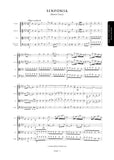Ordonez, Karl von: Symphony in F minor (Brown Fm12) (AE059) – sheet music
Previous Product Next Product
Description |
Ordonez, Karl von (1734-1786)
|
||||||||||||||||||
Details |
For a part-time composer Ordonez was a surprisingly prolific. In addition to his two operatic works - a marionette opera, Musica della Parodie d'Alceste and a Singspiel, Diesmal hat der Mann den Willen - Ordonez is known to have composed a significant amount of church music (now lost), a secular cantata, 73 symphonies, a violin concerto and a large corpus of chamber music of which the 27 authenticated string quartets are of particular importance. Ordonez's sophisticated experiments with cyclic unity and his liking for contrapuntal textures gives much of his music a very distinctive and original quality. His symphonies were widely disseminated in manuscript copies and Abbé Stadler noted that they "received great applause". The present work is listed in the famous Quartbuch catalogue of ca 1775 and is, therefore, roughly contemporaneous with Haydn's 'Sturm und Drang' symphonies and works of similar style and temperament by Ditters and Vanhal. F minor is a very unusual tonality for the period and the choice of key may have been influential in determining the work's instrumentation. While one might expect the omission of horn parts given the technical difficulties inherent in the key, the decision to score the work for strings only serves to further underline its unusual nature given the paucity of string symphonies by Viennese composers. This edition is based on a set of contemporary manuscript parts now in the possession of the Biblioteca Estense in Modena under the shelfmark D286. The wrapper reads "in F mol / Sinfonia / a 2 Violini / Viola / e Basso / Del Sigl Carlo D'ordonez". In the absence of the autograph score or a set of authentic performing parts, the edition seeks to present as faithfully as possible the intentions of the composer as transmitted in the Modena source. The style and notation of articulation and dynamic markings have been standardised throughout, and, where missing, reconstructed from parallel passages. These are indicated by the use of dotted slurs or brackets where appropriate. Like most eighteenth-century sources, the Biblioteca Estense manuscript is inconsistent in its notation of appoggiature; these too have been standardised to minimise confusion. Obvious wrong notes have been corrected without comment; editorial emendations with no authority from the source are placed within brackets. Allan Badley |














